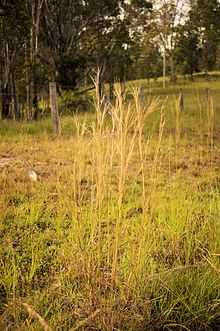Hyparrhenia filipendula
| Hyparrhenia filipendula | |
|---|---|
 | |
| New South Wales, Australia | |
| Scientific classification | |
| Kingdom: | Plantae |
| Clade: | Angiosperms |
| Clade: | Monocots |
| Clade: | Commelinids |
| Order: | Poales |
| Family: | Poaceae |
| Genus: | Hyparrhenia |
| Species: | H. filipendula |
| Binomial name | |
| Hyparrhenia filipendula (Hochst.) Stapf | |
Hyparrhenia filipendula is a species of perennial bunchgrass commonly known as fine thatching grass and fine hood grass. It grows to a height of 1 to 1.5 metres (3.3 to 4.9 ft).[1]
Distribution
H. filipendula is native to semiarid Africa, Southeast Asia, and Australia.[2] It is an important component of acacia savannas with 900–1,000 millimetres (35–39 in) of annual precipitation in East Africa, which includes the wetter parts of the Serengeti ecosystem. It is commonly found in grasslands in combination with Themeda triandra[3] and Hyparrhenia dissoluta.[4]
Uses
H. filipendula is a fodder plant for wild and domestic grazers, but it is not well adapted to heavy grazing.[1] In mixed grasslands with T. tiandra it produces 6.8 grams of dry matter and 0.56 grams of protein per square meter per month per centimeter of rainfall.[3]
References
- ↑ 1.0 1.1 Coughenour, M. B.; S. J. McNaughton, L. L. Wallace (1985-01-01). "Responses of an African tall-Grass (Hyparrhenia filipendula Stapf.) to defoliation and limitations of water and nitrogen". Oecologia 68 (1): 80–86. doi:10.2307/4217801. ISSN 0029-8549. Retrieved 2012-11-25.
- ↑ FAO. "Hyparrhenia filipendula". Retrieved 2012-11-25.
- ↑ 3.0 3.1 Strugnell, R. G.; C. D. Pigott (1978-03-01). "Biomass, shoot-production and grazing of two grasslands in the Rwenzori National Park, Uganda". Journal of Ecology 66 (1): 73–96. doi:10.2307/2259182. ISSN 0022-0477. Retrieved 2012-11-25.
- ↑ Thomas, A. S. (1943-12-04). "The vegetation of the Karamoja District, Uganda: An illustration of biological factors in tropical ecology". Journal of Ecology 31 (2): 149–177. doi:10.2307/2256546. ISSN 0022-0477. Retrieved 2012-11-25.